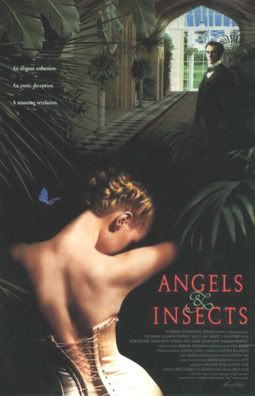Angels and Insects (Philip Haas, 1995)
 Angels & Insects is the best Peter Greenaway film Greenaway himself never made. The story of undlying sexual and emotional pathology in Victorian England, the plot (adapted from a novella by AS Byatt) and imagery reminded me so much of Greenaway's signature style that I had to remind myself several times that it wasn't him. It is the story of William Adamson (Mark Rylance, who was the bright spot for me in Institute Benjamenta and is equally brilliant here), an etymologist who lost all his Amazonian specimens in a shipwreck, now housed by the Alabaster family. He ends up marrying the older daughter Eugenia (a radiant Patsy Kensit), making an enemy of the son Edgar, and becoming great friends and intellectual partners with the younger daughters' tutor, Matty Crompton. As he becomes more and more entrenched in the family, their internal politics and quirks (to put it lightly) are revealed, leading to devastating consequences. William is obsessed with insects, and the Alabaster family is a life-size version of an ant colony, a parallel that is made several times throughout the movie. The Alabasters are no less primal nor complicated than these instinctual creatures. Even though I had known the big twist, when it is revealed, it is no less chilling and distressing than if I hadn't known it at all. Rylance is pitch-perfect in his role as a genuinely good guy who really does come to care for Eugenia and is terribly betrayed. Kristin Scott Thomas as Matty, the voice of sanity in this insular household, is well-suited for her role and performs it pretty well. The imagery of insects pervades the film, and is very much reminiscent of A Zed & Two Noughts' obsession with decay. This Victorian culture is decaying, and modernity is creeping in when the Alabasters had their back turned. They try to hold it back, but it's inevitable. 8/10 RIYL: Peter Greenaway (it's a real mixture of The Draughtsman's Contract and A Zed and Two Noughts) Labels: 1995, philip haas |

Comments on "Angels and Insects (Philip Haas, 1995)"
post a comment